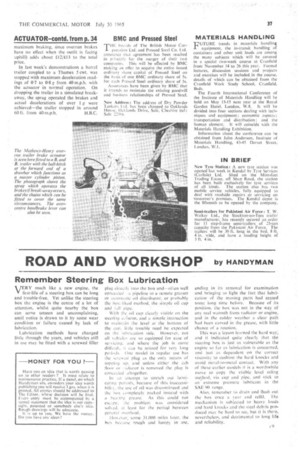TRAILER OVERRUN ACTUATOR WITH SAFETY FEATURES
Page 36

Page 39

If you've noticed an error in this article please click here to report it so we can fix it.
.1–% A NEW hydraulic overrun brake
actuator for trailers, developed in conjunction with the FVRDE and based on units employed for some years on military outfits, is now being offered to commercial users by E. Mathews Hydraulics Ltd., 67 Jeddo Road, London, W.12. It was demonstrated convincingly last week by its designer, Mr. Peter Henry.
The actuator, known as the MathewsHenry, forms part of a ball-hitch coupling and is so designed that the drawbar operates, in effect, as the piston in a special brake master cylinder. Thus the force on the drawbar in the overrun condition is applied to the actuator, which in turn applies the wheel brakes; the pressure is therefore directly proportional to the thrust generated at the drawbar.
An integral feature of the actuator is a damping cylinder which very effectively absorbs fluctua1ions in running loads and damps out hunting.
The model demonstrated had four other important features. A fail-safe addition to the basic design was fitted, in the form of a toothed sprag which, if the trailer breaks free, strikes the ground and immediately applies the brakes; there is a spring-loaded pawl which instantly engages with a ratchet to hold the brakes on in these circumstances. Further security cart be provided by
c6 chains which are attached to the towing vehicle and themselves cause the actuator to operate in the event of break-away.
An overload release avoids the danger of backing up onto the trailer and damaging linkage and so on: the last fraction of an inch of master-cylinder piston travel releases all pressure in the system, so the trailer can be reversed without any need to operate a manual back-up stop; an interference stop prevents this pressure-relief being operated by the sprag or chains in the break-away condition. A hand parking brake of new design ensures that the brakes cannot be left partly on when the outfit moves off, yet still allows them to be " inched" for manhandling the trailer:
The Construction and Use Regulations permit overrun brakes to be employed on trailers not exceeding 1 ton unladen, or those carrying essentially fixed equipment and weighing not more than 2 tons 5 cwt. complete, or living vans not exceeding 2 tons unladen.
A complete coupler/actuator outfit with damper, sprag, chains and back-up release will cost about £38, or £32 if ordered in quantity; without the breakaway equipment the figures would be about £29 and 125 respectively, while conversion of actual brakes to twoleading-shoe (which is recommended for
to 10 years away from commercial production ".
The Turbo Titan III, is designed to operate at a gross train weight of 34-2 tons and the gas turbine drives through a conventional Allison automatic transmission with torque convertor and hydraulic-retarder sections omitted. These are said to be not required with the turbine and the remainder of the transmission is an Allison six-speed automatic unit. The chassis design is conventional, with a 6-7-ton front axle and 15.2-ton-capacity tandem rear bogie. Both rear axles have two-speed spiralbevel-drive units with ratios of 7-17 and 9-77 to 1. But only the 7-17 to 1 ratio is used as it is most compatible with the speed and output of the gas-turbine engine. Braking is by a full air system with 17-25 in. by 3-5 in. units at the front and 15 in. by 7 in. units at the rear. Lowprofile 18-19-5 tyres are used at the rear bogie, the fronts being 10.00-20.
The cab is built of reinforced plastics with some steel parts, and it tilts forward for access to the gas-turbine engine. The lower side panels extend to the rear from the cab to give deep side skirts and go over the frame to form a flat deck. The tilting mechanism is power operated and the cab also has power-operated wing-type side windows hinged at the top. As the doors are opened, the windows lift open to provide access to the cab.
Large air intakes at the bottom front corners of the cab honk retractable triple headlights. The bottom lamps in each bank are special units for use on motorway-type roads. Front flashing direction indicators are also retractable, these being located between the edge of the air intakes and the doors.
The interior of the cab matches the external styling, the two seats being " astronaut type" and having headrests to give maximum comfort. Full carpeting is provided, and included in the many comfort features is an airconditioning unit.
maximum braking, since overrun brakes have no effect when the outfit is facing uphill) adds about £12/E13 to the total price.
In last week's demonstrations a barrel trailer coupled to a Thames 5 cwt. was stopped with maximum deceleration readings of 0.7 to 0-8 g from 40 m.p.h. with the actuator in normal operation. On dropping the trailer in a simulated breakaway, the sprag operated the brakes and actual decelerations of over 1 g were achieved—the trailer stopped in around 60 ft. from 40 m.p.h,












































































































